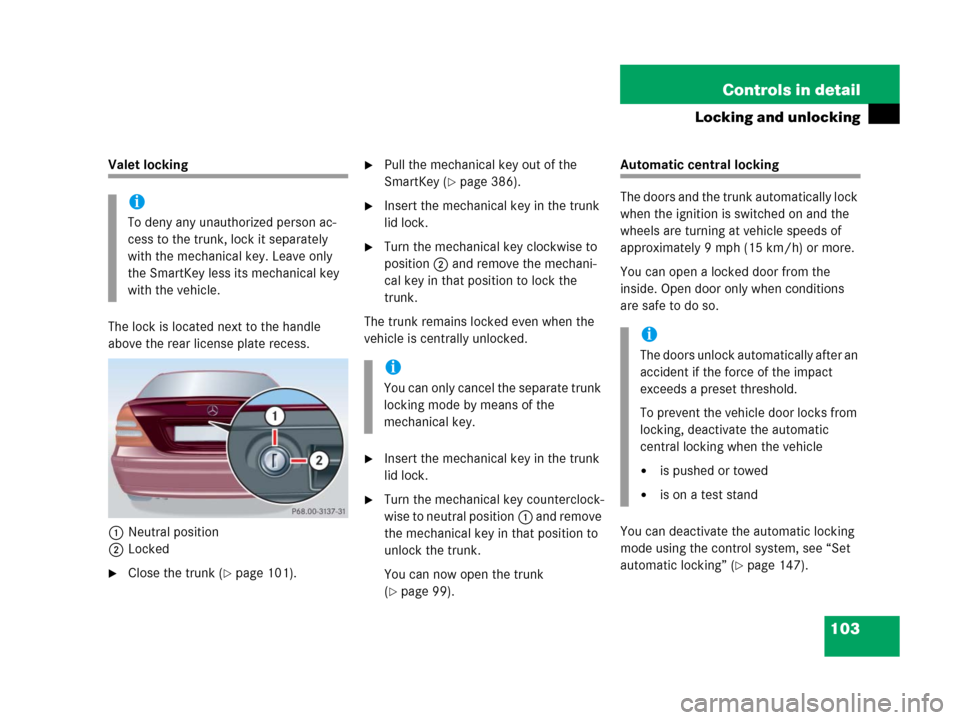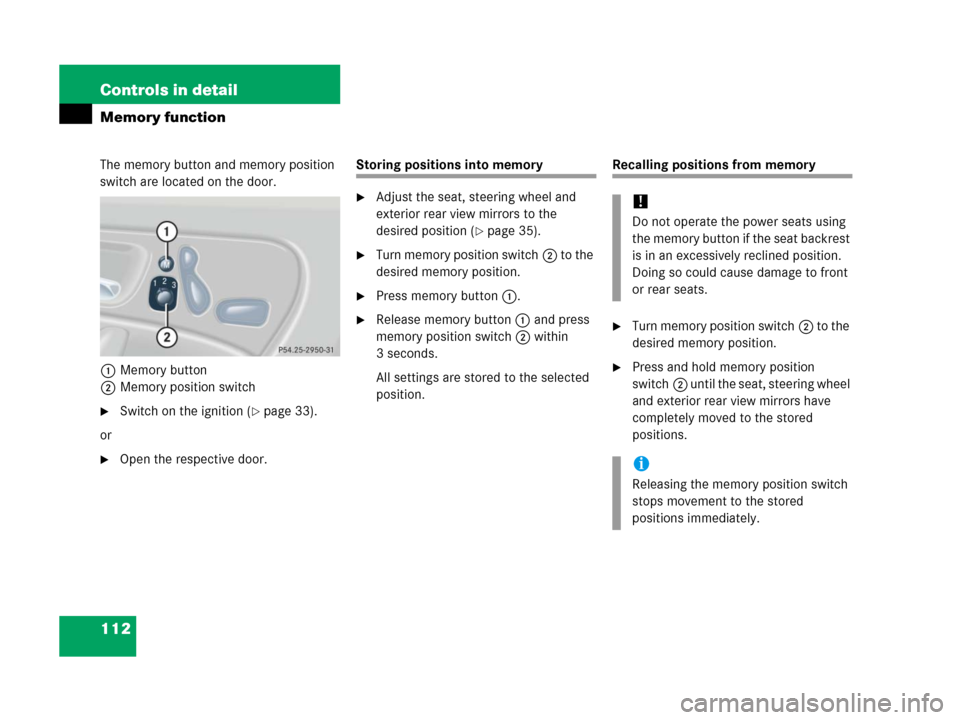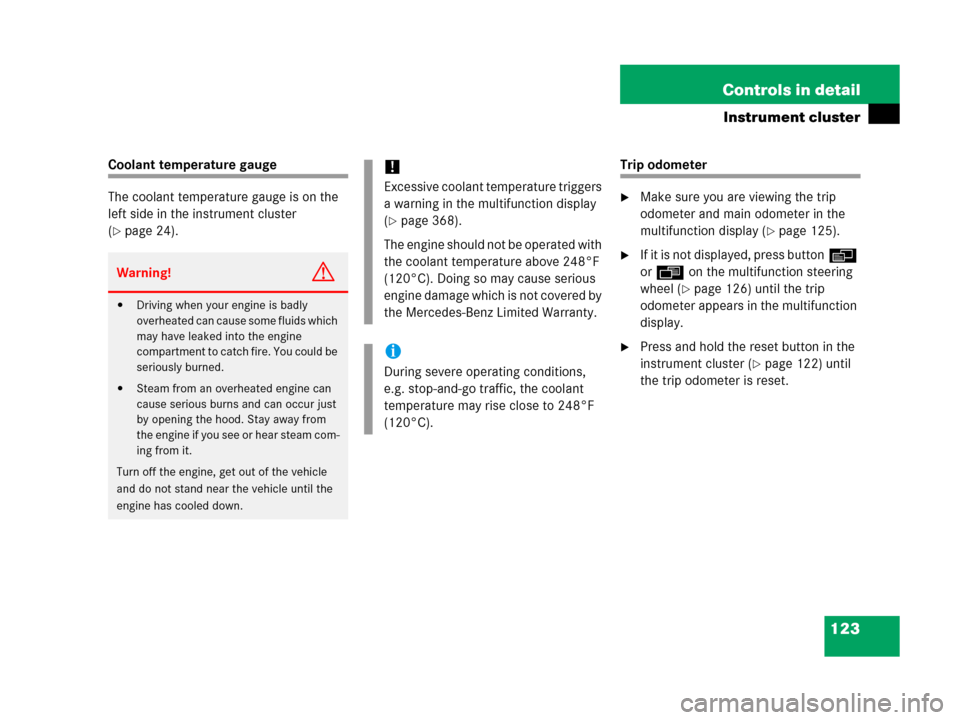Page 104 of 473

103 Controls in detail
Locking and unlocking
Valet locking
The lock is located next to the handle
above the rear license plate recess.
1Neutral position
2Locked
�Close the trunk (�page 101).
�Pull the mechanical key out of the
SmartKey (
�page 386).
�Insert the mechanical key in the trunk
lid lock.
�Turn the mechanical key clockwise to
position2 and remove the mechani-
cal key in that position to lock the
trunk.
The trunk remains locked even when the
vehicle is centrally unlocked.
�Insert the mechanical key in the trunk
lid lock.
�Turn the mechanical key counterclock-
wise to neutral position1 and remove
the mechanical key in that position to
unlock the trunk.
You can now open the trunk
(
�page 99).
Automatic central locking
The doors and the trunk automatically lock
when the ignition is switched on and the
wheels are turning at vehicle speeds of
approximately 9 mph (15 km/h) or more.
You can open a locked door from the
inside. Open door only when conditions
are safe to do so.
You can deactivate the automatic locking
mode using the control system, see “Set
automatic locking” (
�page 147).
i
To deny any unauthorized person ac-
cess to the trunk, lock it separately
with the mechanical key. Leave only
the SmartKey less its mechanical key
with the vehicle.
i
You can only cancel the separate trunk
locking mode by means of the
mechanical key.
i
The doors unlock automatically after an
accident if the force of the impact
exceeds a preset threshold.
To prevent the vehicle door locks from
locking, deactivate the automatic
central locking when the vehicle
�is pushed or towed
�is on a test stand
Page 112 of 473

111 Controls in detail
Memory function
�Memory function
Prior to operating the vehicle, the driver
should check and adjust the seat height,
seat position fore and aft, and seat back-
rest angle if necessary, to ensure adequate
control, reach and comfort. The head re-
straint should also be adjusted for proper
height. See also the section on air bags
(
�page 61) for proper seat positioning.
In addition, adjust the steering wheel to
ensure adequate control, reach, operation
and comfort. Both the interior and exterior
rear view mirrors should be adjusted for
adequate rear vision.
Fasten seat belts. Infants and small chil-
dren should be seated in a properly se-
cured restraint system that complies with
U.S. Federal Motor Vehicle Safety
Standards 213 and 225 and Canadian Mo-
tor Vehicle Safety Standards 213
and 210.2.With the memory function you can store up
to three different settings.
The following settings are stored for the
driver’s seat when using the buttons on the
driver’s door:
�Driver’s seat, backrest and head
restraint position
�Steering wheel position
�Exterior rear view mirrorsThe following settings are stored for the
front passenger seat when using the but-
tons (if so equipped depending on vehicle
equipment configuration) on the passen-
ger door:
�Front passenger seat, backrest and
head restraint position
Warning!G
Do not activate the memory function while
driving. Activating the memory function
while driving could cause the driver to lose
control of the vehicle.
Page 113 of 473

112 Controls in detail
Memory function
The memory button and memory position
switch are located on the door.
1Memory button
2Memory position switch
�Switch on the ignition (�page 33).
or
�Open the respective door.
Storing positions into memory
�Adjust the seat, steering wheel and
exterior rear view mirrors to the
desired position (
�page 35).
�Turn memory position switch2 to the
desired memory position.
�Press memory button1.
�Release memory button1 and press
memory position switch2 within
3 seconds.
All settings are stored to the selected
position.
Recalling positions from memory
�Turn memory position switch2 to the
desired memory position.
�Press and hold memory position
switch2 until the seat, steering wheel
and exterior rear view mirrors have
completely moved to the stored
positions.
!
Do not operate the power seats using
the memory button if the seat backrest
is in an excessively reclined position.
Doing so could cause damage to front
or rear seats.
i
Releasing the memory position switch
stops movement to the stored
positions immediately.
Page 114 of 473
113 Controls in detail
Memory function
Storing exterior rear view mirror
parking position
For easier parking, you can adjust the
passenger-side exterior rear view mirror so
that you can see the right rear wheel as
soon as you engage reverse gearR.
For information on activating the parking
position feature, see “Activating exterior
rear view mirror parking position”
(
�page 170).1Memory button
2Adjustment button
3Passenger-side exterior rear view
mirror button
�Stop the vehicle in a safe location.
�Switch on the ignition (�page 33).
�Press button3.
The passenger-side exterior rear view
mirror is selected.
�Adjust the exterior rear view mirror
with button2 so that you see the rear
wheel and the road curb.
�Press memory button1.
�Within 3 seconds, press bottom of ad-
justment button2.
The parking position is stored if the
mirror does not move.
i
If the mirror does move, repeat the
above steps. After the setting is stored,
you can move the mirror again.
Page 115 of 473

114 Controls in detail
Lighting
For information on how to switch on the
headlamps and use the turn signals, see
“Switching on headlamps” (
�page 48)
and “Turn signals” (
�page 49).
Exterior lamp switch
The exterior lamp switch is located on the
dashboard to the left of the steering wheel.
Exterior lamp switch
MOff
Daytime running lamp mode
(
�page 116)
UAutomatic headlamp mode
Daytime running lamp mode
(
�page 116)
CParking lamps (also tail lamps,
license plate lamps, side marker
lamps, instrument panel lamps)
BLow beam headlamps (or high
beam headlamps when the
combination switch is pushed
forward) and parking lamps
ˆStanding lamps, right (turn left one
stop)
‚Standing lamps, left (turn left two
stops)
‡Indicator lamp for front fog lamps
†Indicator lamp for rear fog lampi
If you drive in countries where vehicles
drive on the other side of the road than
the country where the vehicle is regis-
tered, you must have the headlamps
modified for symmetrical low beams.
Relevant information can be obtained
at your authorized Mercedes-Benz
Center.
Page 124 of 473

123 Controls in detail
Instrument cluster
Coolant temperature gauge
The coolant temperature gauge is on the
left side in the instrument cluster
(
�page 24).
Trip odometer
�Make sure you are viewing the trip
odometer and main odometer in the
multifunction display (
�page 125).
�If it is not displayed, press buttonè
orÿ on the multifunction steering
wheel (
�page 126) until the trip
odometer appears in the multifunction
display.
�Press and hold the reset button in the
instrument cluster (
�page 122) until
the trip odometer is reset.
Warning!G
�Driving when your engine is badly
overheated can cause some fluids which
may have leaked into the engine
compartment to catch fire. You could be
seriously burned.
�Steam from an overheated engine can
cause serious burns and can occur just
by opening the hood. Stay away from
the engine if you see or hear steam com-
ing from it.
Turn off the engine, get out of the vehicle
and do not stand near the vehicle until the
engine has cooled down.
!
Excessive coolant temperature triggers
a warning in the multifunction display
(
�page 368).
The engine should not be operated with
the coolant temperature above 248°F
(120°C). Doing so may cause serious
engine damage which is not covered by
the Mercedes-Benz Limited Warranty.
i
During severe operating conditions,
e.g. stop-and-go traffic, the coolant
temperature may rise close to 248°F
(120°C).
Page 126 of 473

125 Controls in detail
Control system
�Control system
The control system is activated as soon as
the SmartKey in the starter switch is
turned to position1. The control system
enables you to
�call up information about your vehicle
�change vehicle settings
For example, you can use the control
system to find out when your vehicle is
next due for service, to set the language
for messages in the instrument cluster
display, and much more.
The control system relays information to
the multifunction display.
Multifunction display
1Trip odometer
2Main odometer
3Current program mode
(automatic transmission)
4Current gear selector lever
position/gear range
(automatic transmission)
5Digital clock
6Status indicator (outside tempera-
ture/digital speedometer)
i
The displays for the audio systems
(radio, CD player) will appear in English,
regardless of the language selected.
Warning!G
A driver’s attention to the road and traffic
conditions must always be his/her primary
focus when driving.
For your safety and the safety of others,
selecting features through the multifunction
steering wheel should only be done by the
driver when traffic and road conditions
permit it to be done safely.
Bear in mind that at a speed of just 30 mph
(approximately 50 km/h), your vehicle is
covering a distance of 44 feet
(approximately 14 m) every second.
Page 127 of 473

126 Controls in detail
Control system
Multifunction steering wheel
The displays in the multifunction display
and the settings in the control system are
controlled by the buttons on the multifunc-
tion steering wheel.Depending on the selected menu
(
�page 129), pressing the buttons on the
multifunction steering wheel will alter what
is shown in the multifunction display.
The information available in the multifunc-
tion display is arranged in menus, each
containing a number of functions or sub-
menus.
The individual functions are then found
within the relevant menu (radio or CD op-
erations under
Audio, for example). These
functions serve to call up relevant informa-
tion or to customize the settings for your
vehicle.
1Multifunction display
Operating the control system
2Telephone*:
Press button
sto take a call
to dial a call
tto end a call
to reject an incoming call
3Selecting the submenu or setting
the volume:
Press button
æup/to increase
çdown/to decrease
4Menu systems:
Press button
èfor next menu
ÿfor previous menu
5Moving within a menu:
Press button
jfor next display
kfor previous display